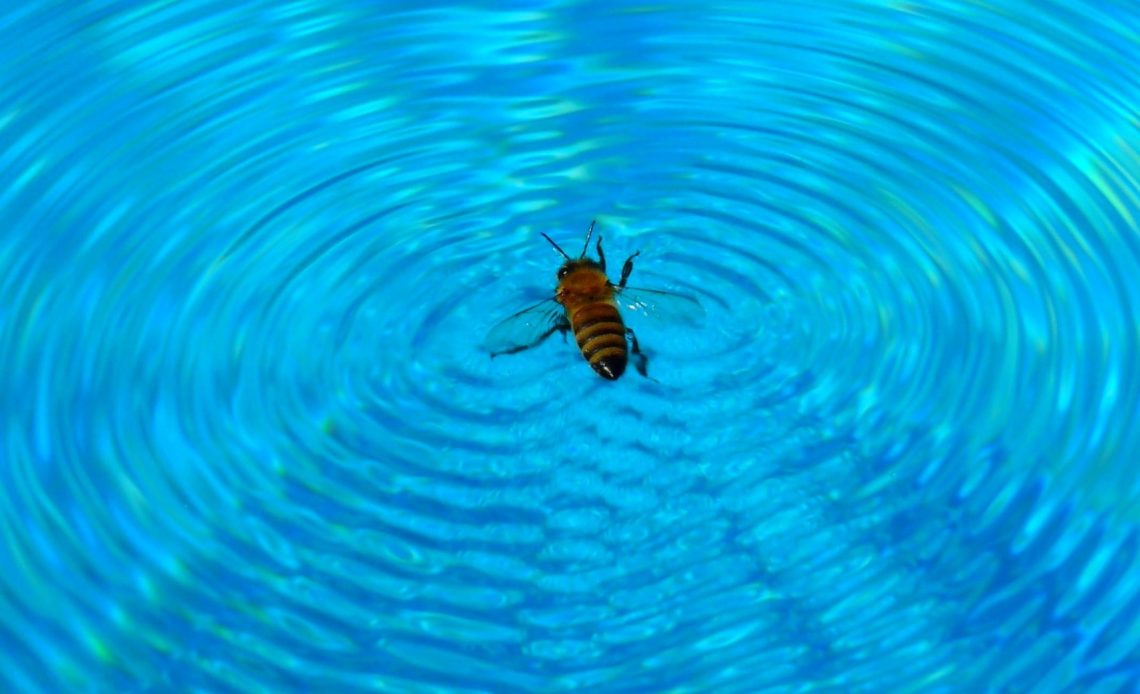

We’re here to help! Wild Yards is a completely free website that is 100% dedicated to helping you create a wildlife-friendly, sustainable yard. Read more
WildYards is reader-supported. When you buy a product through a link on our site, we may earn a comission. Every product is independently selected by our (obsessive) editors and our reviews are unbiased and objective. Read more about our mission or our privacy policy.
Bees have always been impressive creatures. They play a vital role in our ecosystem, and you may have seen one or two floating around near your water basin. This has probably made you wonder – can bees swim?
Bees can’t technically swim, but they can hydrofoil or surf when they land on water! They cannot swim because their wings haven’t evolved to move in such a way. However, bee hydrofoiling techniques are pretty impressive all on their own.
What is hydrofoiling?
Hydrofoiling, in the bee world, is a little like surfing – bees have the ability to create waves if they come into contact with water, or if they find themselves submerged.
To put it simply, when bees land in water, their wings naturally get wet. The water on their wings weighs them down, making it impossible to fly away safely. Instead of swimming, bees use their wings to create strong ripples in the water. They then essentially surf the ripples until they reach the shore or relative safety.
However, hydrofoiling does require a lot of effort – they can normally do this for up to ten minutes. If you’re already welcoming bees to your garden and have a few pools of water, you may likely have seen them giving this a go!
Can bees drown?
Sadly, bees can drown, though they are unlikely to because they can hydrofoil. Bees can also hold their breaths for a long period, making their underwater survival chances stronger. However, this will normally only last for up to five minutes, meaning they always need to come back to hydrofoiling or rippling across the water.
Studies show that bees can and will help each other in times of distress, such as when one of their hive appears to be drowning. However, too many bees piling into the water could create further panic and potential fatalities. Therefore, they do not always launch rescue efforts unless the circumstances are especially dire.
Bees can drown in honey and water – though both circumstances are quite rare, vigilance is important.
How can I rescue a bee from drowning?
If you notice a bee has landed in the water and may be struggling, the best thing to do is scoop them out gently with a flat object and place them somewhere dry.
You can revive bees with sugar water in some cases, but make sure to choose sugar that’s natural or granulated. It’s worth leaving a little of this sugar water under its mouth to sup at its own pace. Then, you should simply leave the bee to dry out and come around. They will likely fly away once they have fully recovered.
It’s always a good idea to be careful when touching or approaching bees in any way shape or form – as bee wings are highly sensitive, and if they feel you are threatening them, they will not hesitate to attack you.
Why do bees go near water?
Like most creatures, bees need water. They commonly drink from birdbaths, pools, puddles, and more. Therefore, they may commonly find themselves falling into water if they are too overzealous in their hydration habits!
However, they also need water to cool down. In particularly hot areas, the bees will use the water to cool themselves – and their hive – to comfortable temperatures.
On the whole, the nectar that bees drink from the flowers in your garden won’t contain enough water to sustain them. It’s a key reason why so many bees are attracted to large bodies of water – including artificial pools. You should still grow a variety of flowers for bees, but they will need somewhere fresh to drink from so they can keep working hard!
How to help keep water safe for bees in your garden
You may think you already have a perfectly good birdbath in your garden that you may have even found bees drinking out of. However, there are ways of making that bath even safer for the bees in your garden. Consider raising the bed of the bath up with stones, or adding a few floating surfaces.
Alternatively, why not create a new, dedicated bee water source? You can start by providing them with their own water source. Using a chicken feeder, a small pot, or even a dish will do the trick. However, if you are concerned about the depth of the dish, then simply add some stones at the bottom. These will help to ensure that the bees have a way of walking along the bottom of the dish, should they fall in.
Some wild yard owners even choose to place floating objects in there that the bees can climb upon. Small, floating detritus such as pieces of wood, corks, even a rubber duck will do the trick! There are plenty of ways to create your own bee watering stations.
Leave the water in an area that will be easy for the bees to find, and remember to clean it regularly. It is also important to note that water can evaporate relatively quickly in shallow water dishes. Therefore, it is wise to use a fairly deep dish – and remember to put floating objects in it, or simply remember to check on the water source regularly.
Bees are amazing little critters and, while they can’t swim, they have brilliant mechanisms for getting out of water in a pinch. Be sure to attract bees to your garden with flowers they love, and offer up a little drinking water here and there to keep their interest.
